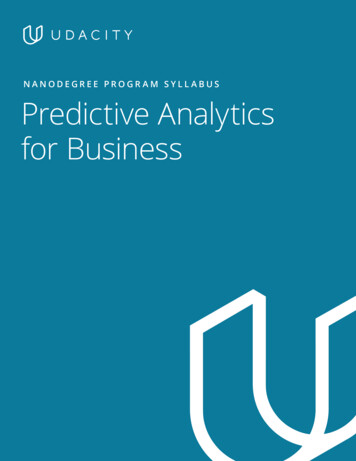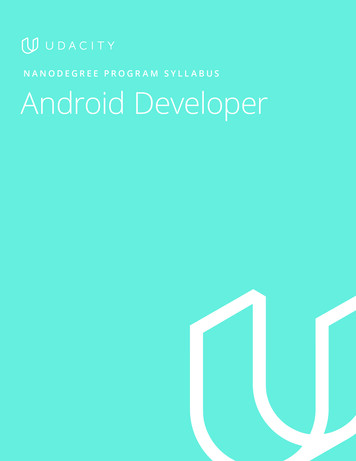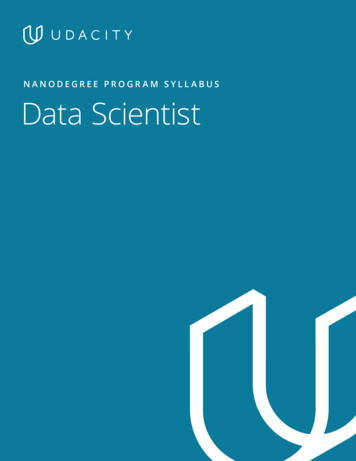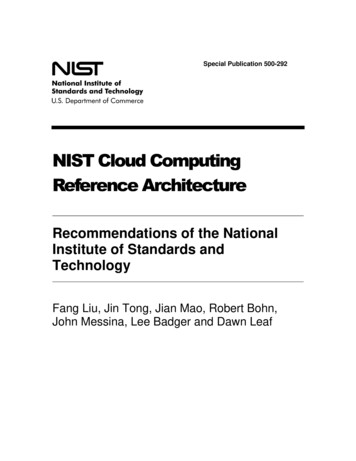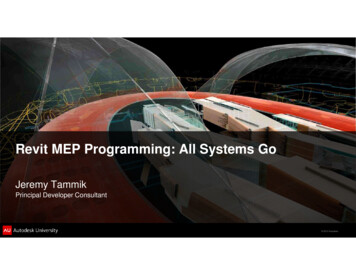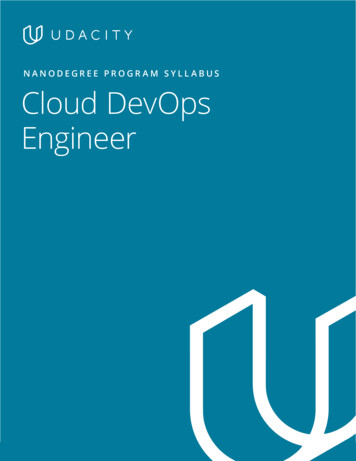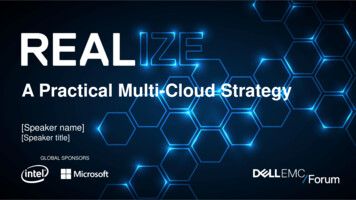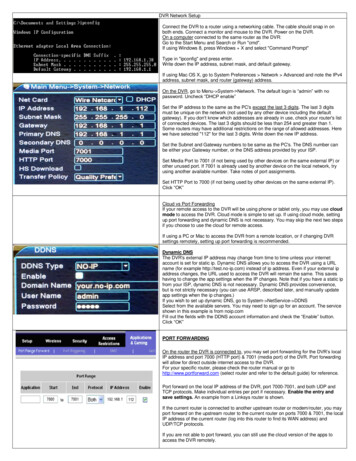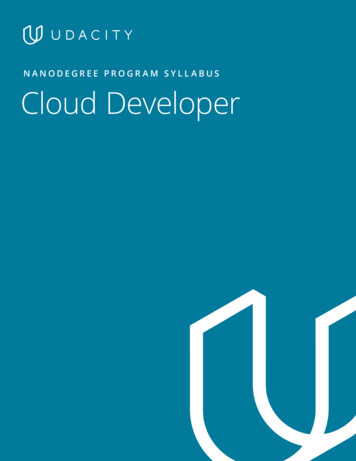
Transcription
NANODEGREE PROGR AM SYLL ABUSCloud Developer
OverviewStart by learning the fundamentals of cloud development and deployment with AWS. Then, build differentapps leveraging microservices, Kubernetes clusters, and serverless application technology.Estimated Time:4 Months at10 hrs/weekFlexible Learning:Self-paced, soyou can learn onthe schedule thatworks best for youPrerequisites:IntermediateJavascriptTechnical MentorSupport:Our knowledgeablementors guide yourlearning and arefocused on answeringyour questions,motivating you andkeeping you on trackCloud Developer 2
Course 1: Cloud FundamentalsThe cloud has become a key enabler for innovation with beneficial features like high availability, unlimitedcapacity, and on-demand scalability and elasticity. Learn the fundamentals of cloud computing while beingintroduced to compute power, security, storage, networking, messaging, and management services in thecloud. While learning the fundamentals, you will explore tools and services offered by Amazon Web Services(AWS) through interactive hands-on exercises. By the end of the course, you will have deployed your firstwebsite to AWS.Course ProjectDeploy Static Website onAWSThe cloud is perfect for hosting static websites that only includeHTML, CSS, and JavaScript files that require no server-sideprocessing. In this project, you will deploy a static website to AWS.First, you will create a S3 bucket, configure the bucket for websitehosting, and secure it using IAM policies. Next, you will upload thewebsite files to your bucket and speed up content delivery usingAWS’s content distribution network service, CloudFront. Lastly, youwill access your website in a browser using the unique S3 endpoint.LEARNING OUTCOMESLESSON ONELESSON TWOLESSON THREECloud Overview Learn the basics of cloud computing including clouddeployment models, benefits, and popular options Explore services provided by Amazon Web Services(AWS)Foundational andCompute Services Learn why we need servers, compute power, and security Explore AWS compute services like Elastic Cloud Compute(EC2), Virtual Private Cloud (VPC), Lambda for serverlessframework, and Elastic Beanstalk in action Launch a secure EC2 instance, create and execute aLambda, and deploy an application to Elastic BeanstalkStorage and contentdelivery Learn why we need storage and content delivery in thecloud Learn storage services like S3, DynamoDB, RelationalDatabase Service (RDS), and CloudFront Create a DynamoDB table, launch a MySQL databaseinstance, and create a CloudFront distributionCloud Developer 3
LEARNING OUTCOMESLESSON FOURSecurity Learn the importance of security in the cloud See Identity & Access Management (IAM) in action Secure applications using IAM users, groups, and policiesLESSON FIVENetworking &Elasticity Learn the basics of networking and elasticity in the cloud Examine services like Route 53, EC2 Auto Scaling, andElastic Load Balancing Add an auto scaling policy to your EC2 instanceMessaging &Containers Learn the basics of messaging and containers in the cloud Explore services like Simple Notification Service (SNS),Simple Queue Service (SQS), and Elastic Container Service(ECS) Create cloud notifications using SNSAWS Management Learn why we need logging, auditing, and resourcemanagement in the cloud Understand services like Cloud Watch, Cloud Trail, CloudFormation, and the AWS Command Line Interface (CLI) Explore the CLILESSON SIXLESSON SEVENCloud Developer 4
Course 2: Full Stack Apps on AWSExplore the foundational concepts of designing and deploying scalable, extendable, and maintainable fullstack applications using modern cloud architecture. All concepts are covered at a fundamental level andmotivated with practical, real world programming exercises. Through the course, you’ll have built anddeployed a multi-service cloud stack. By the end of this course, you’ll understand key design decisions anduseful tools to maintain your application.Course ProjectUdagram: your ownInstagram on AWSIn this project, you will develop a cloud-based application foruploading, listing, and filtering images. You will use Node.jsExpress, a popular javascript framework for networked applicationdevelopment to develop this application. You will implement a RESTAPI to issue commands using HTTP, store data in Amazon WebServices Relational Data Service (RDS) and S3, extend the codebasewith secure authentication signon features, and deploy to AmazonWeb Services Elastic Beanstalk. These are the hard skills you’ll needin any Cloud developer role.LEARNING OUTCOMESCloud Basics Learn key terminology and building blocks of a cloudsystem Understand design paradigm of modern cloud applicationsLESSON TWOSet up Best Practices Implement a process so you write quality code, workingalone or on teams. Lear unit and integration testing, a better way to git, andhow to use packaged dependencies.LESSON THREEStoring Data in theCloud Set up and start using a cloud-based relational database forstoring user data using AWS RDS Implement a filestore for media like images using AWS S3LESSON ONECloud Developer 5
LEARNING OUTCOMESLESSON FOURDeploying to theCloud Consume cloud data services (database and filestore)within your server application Deploy your application using AWS Elastic Beanstalk.LESSON FIVEUser Authenticationand Security Learn common mistakes and modern techniques fordealing with security and new set of cloud authenticationchallengesLESSON SIXScaling and Fixing Cloud systems need to be maintained as dependencies areupdated and there is more demand for your service.Explore tools and process to minimize growing painsCloud Developer 6
Course 3: Monolith to Microservices at ScaleMicroservices are becoming the default mode of developing and deploying applications at scale. Themicroservices architecture makes it easier to scale an application to a large system and is a greatenabler for continuous integration and delivery. Microservices architecture allows independent scaling,independent releases and deployments and independent development so that each service has its owncodebase. In this course we will cover the best practices on how to develop and deploy microservices.You will learn topics such as different microservice architecture patterns, independent scaling, resiliency,service replication, service registration and discovery. By the end of this course, you should be able todesign and build an application using a microservice architecture.Course ProjectRefactor Udagram app toMicroservicesIn this project, you will reuse their existing Udagram applicationand convert and extend into a microservice architecture. After theapplication is divided into smaller service, you will containerize itand deploy it to a Kubernetes cluster. This includes the deploymentpipeline, scalability, observability, services, networking, anddeployment strategies to service the system. You will thenimplement and interpret performance, usage, and logs to solve realproblems similar to those they would encounter in the field.LEARNING OUTCOMESLESSON ONEMicroservices DesignPrinciples and bestPractices Learn different microservices architecture designs how todivide an application into microservicesLESSON TWOIndependentReleasesand Deployments Understand CI/CD benefits and use Travis to build CI/CDpipeline Integrate github and CI/CD and automate testing with CILESSON THREEContainers usingDocker Build and run your first container image using Docker Debug container and store these images using containerregistryCloud Developer 7
LEARNING OUTCOMESLESSON FOURServiceOrchestrationwith Kubernetes Learn the fundamentals of Kubernetes Configure and launch a auto-scaling, self-healingKubernetes cluster Deploy your microservices using Kubernetes clusterLESSON FIVEService Registration,Discovery andScaling Implement service registration and discovery Configure scaling and self-healing for each serviceLESSON SIXDebugging,Monitoringand Logging Learn best practices for debugging microservices Implement monitoring and logging for microservices Understand how to build resilience in your applicationCloud Developer 8
Course 4: Develop & Deploy Serverless AppServerless technologies have become very popular recently because they can increase the speed ofdevelopment and drastically reduce the cost of running a cloud infrastructure. This course combines thetheory of using serverless technologies with the practice of developing a complex serverless application.You will learn advanced serverless features such as implementing WebSockets and stream processing,and learn about serverless best practices throughout the course.Course ProjectServerless ApplicationIn this project you will develop an Instagram-like serverless servicefor uploading, listing, and filtering images. You will begin withbuilding serverless REST APIs using API Gateway and AWS Lambda, astack of serverless technologies on AWS. You will then implement anAPI to interact with this application, store data in AWS DynamoDB,S3, and Elasticsearch, secure your application with authentication,and deploy to Amazon Web Services using a Serverless framework.The purpose of the cloud development capstone project is to giveyou a chance to combine what you’ve learned throughout theprogram. This project will be an important part of your portfolio thatwill help you achieve your cloud development-related career goals.In the capstone project, each project is unique to the student. You’llbuild an application on AWS based on predefined criteria. Studentswill define the scope of the project, come up feature list and decidewhich AWS services to use to meet availability and performancecriteria.Course ProjectCapstone ProjectLEARNING OUTCOMESLESSON ONEIntroduction toServerless Learn the main components of a serverless application Implement simple application using Function as a Service(FaaS)LESSON TWOREST APIs forServerless Build a simple REST API using serverless technologies suchas API Gateway, AWS Lambda, and AWS DynamoDB and useit in React based web applicationCloud Developer 9
LESSON THREEServerlessFramework Build, package and deploy serverless applications usingServerless framework Implement additional features using advanced DynamoDBfeaturesLESSON FOUREvents Processingwith Serverless Improve our application using FaaS ability to executecustom logic when particular events occur in the system Add WebSockets support and full-text search to your appLESSON FIVEImplementingAuthentication Implement authentication in a serverless application usingpopular serverless service Auth0 in your app API and clientapplication. Learn to store secrets for our serverless application usingAWS Secrets ManagerLESSON SIXServerless bestPractices Learn how to test serverless applications, minimize risk ofvendor lock-in, create multiple stages of our API andimprove security and observability of our applicationCloud Developer 10
Our Classroom ExperienceREAL-WORLD PROJECTSBuild your skills through industry-relevant projects. Getpersonalized feedback from our network of 900 projectreviewers. Our simple interface makes it easy to submityour projects as often as you need and receive unlimitedfeedback on your work.KNOWLEDGEFind answers to your questions with Knowledge, ourproprietary wiki. Search questions asked by other students,connect with technical mentors, and discover in real-timehow to solve the challenges that you encounter.WORKSPACESSee your code in action. Check the output and quality ofyour code by running them on workspaces that are a partof our classroom.QUIZZESCheck your understanding of concepts learned in theprogram by answering simple and auto-graded quizzes.Easily go back to the lessons to brush up on conceptsanytime you get an answer wrong.CUSTOM STUDY PLANSCreate a custom study plan to suit your personal needsand use this plan to keep track of your progress towardyour goal.PROGRESS TRACKERStay on track to complete your Nanodegree program withuseful milestone reminders.Cloud Developer 11
Learn with the BestKesha WilliamsGabr iel Ru t t nerI N S T R U C TO RI N S T R U C TO RKesha has over 20 years experience insoftware development and is a softwareengineering manager at Chick-fil-A,routinely leading innovation teams inproving out the use of cloud services tosolve complex business problems. Shewas recently named an Alexa Championby Amazon.Gabe is the CTO at Ursa & Tech Advisor forStart-Ups. Gabe has expertise in buildingcloud-based machine learning and naturallanguage processing services at earlystage tech companies. He holds technicaldegrees from Cornell University and StonyBrook University.Sebastian ScheeleIvan MushketykI N S T R U C TO RI N S T R U C TO RSebastian is the CEO and co-founder ofLoodse, where he wants to empower ITteams to focus on their core expertise:writing groundbreaking applications. Heis a CNCF Ambassador and has publishedseveral articles on Kubernetes in leadingtech media including The New Stack.Ivan formerly worked at Amazon WebServices (AWS), where he built features forcloud services such as CloudWatch, andhis professional experience includes cloud,networking and blockchain. Ivan is also aprolific Open Source contributor, blogger,and online instructor.Cloud Developer 12
Learn with the BestAndrew WongEdd y Shy uI N S T R U C TO RC U R R I C U LU M M A N A G E RAndrew is a Course Developer who enjoysmaking the world a better place throughcode. He first discovered his passion forteaching as an instructor at App Academy,and continues to enjoy empoweringstudents to advance their education.Eddy has worked at BlackRock, ThomsonReuters, and Morgan Stanley, and hasan MS in FInancial Engineering from HECLausanne. Eddy taught data analytics atUC Berkeley and contributed to Udacity’sSelf-Driving Car and Artificial Intelligencefor Trading programs.Bryan OkekeC U R R I C U LU M M A N A G E RBryan’s been lead developer for severalmajor companies, including Bytemark,which handles payments for transit authorities in major cities. He is the founderof Beginner Programmers, the largestblockchain meetup group in the world. Hisbootcamps have taught tens of thousandsof people how to code.Cloud Developer 13
All Our Nanodegree Programs Include:EXPERIENCED PROJECT REVIEWERSREVIEWER SERVICES Personalized feedback & line by line code reviews 1600 Reviewers with a 4.85/5 average rating 3 hour average project review turnaround time Unlimited submissions and feedback loops Practical tips and industry best practices Additional suggested resources to improveTECHNICAL MENTOR SUPPORTMENTORSHIP SERVICES Questions answered quickly by our team oftechnical mentors 1000 Mentors with a 4.7/5 average rating Support for all your technical questionsPERSONAL CAREER SERVICESC AREER SUPPORT Github portfolio review LinkedIn profile optimizationCloud Developer 14
Frequently Asked QuestionsPROGR AM OVERVIE WWHY SHOULD I ENROLL?The cloud developer field is expected to continue growing rapidly over thenext several years, and there’s huge demand for cloud developers acrossindustries.Udacity has collaborated with industry professionals to offer a world-classlearning experience so you can advance your software development career.You will get hands-on experience building and deploying full stack apps,converting monolith to microservices and developing serverless app on thecloud, and more. Udacity provides high-quality support as you master indemand skills that will qualify you for high-value jobs in cloud computing fieldand help you land a job you love.By the end of the Nanodegree program, you will have an impressive portfolioof real-world projects and valuable hands-on experience.WHAT JOBS WILL THIS PROGRAM PREPARE ME FOR?This program is designed to prepare students to become Cloud Developers.This includes job titles such as cloud developer, full stack developer, cloudengineers, and others. Cloud development skills are also helpful for adjacentsoftware engineering roles.HOW DO I KNOW IF THIS PROGRAM IS RIGHT FOR ME?This Nanodegree program offers an ideal path for experienced software/webdevelopers to advance their career. If you enjoy building web applicationsand want to learn to learn how to build them on cloud, this is a great way toget hands-on practice with a variety of cloud computing principles and bestpractices.The prerequisites for this program include proficiency in JavaScript and Webdevelopment (HTML, CSS). You should also be comfortable with linux basiccommands and object-oriented programming concepts.ENROLLMENT AND ADMISSIONDO I NEED TO APPLY? WHAT ARE THE ADMISSION CRITERIA?There is no application. This Nanodegree program accepts everyone,regardless of experience and specific background.WHAT ARE THE PREREQUISITES FOR ENROLLMENT?To optimize your success in this program, we’ve created a list of prerequisitesand recommendations to help you prepare for the curriculum. To enroll, youshould have experience in the following:Cloud Developer 15
FAQs Continued Intermediate programming skills in JavascriptYou should also have some familiarity with: Web development (HTML, CSS) Object Oriented Programming Linux Command Line BasicsIF I DO NOT MEET THE REQUIREMENTS TO ENROLL, WHAT SHOULD I DO?If you believe you need more preparation, here are some additional resourcesyou can use: Intro to Computer Science Linux Command Line Basics Intro to Programming Nanodegree program Front End Web Developer NanodegreeTUITION AND TERM OF PROGR AMHOW IS THIS NANODEGREE PROGRAM STRUCTURED?The Cloud Developer Nanodegree program is comprised of content andcurriculum to support 5 (five) projects. We estimate that students can completethe program in four (4) months working 10 hours per week.Each project will be reviewed by the Udacity reviewer network. Feedback willbe provided and if you do not pass the project, you will be asked to resubmitthe project until it passes.HOW LONG IS THIS NANODEGREE PROGRAM?Access to this Nanodegree program runs for the length of time specified inthe payment card above. If you do not graduate within that time period, youwill continue learning with month to month payments. See the Terms of Useand FAQs for other policies regarding the terms of access to our Nanodegreeprograms.CAN I SWITCH MY START DATE? CAN I GET A REFUND?Please see the Udacity Nanodegree program FAQs for policies on enrollment inour programs.S O F T WA R E A N D H A R D WA R EWHAT SOFTWARE AND VERSIONS WILL I NEED IN THIS PROGRAM?For this Nanodegree program, you will need a desktop or laptop computerrunning recent versions of Windows, Mac OS X, or Linux and an unmeteredbroadband Internet connection. For an ideal learning experience, a computerwith Mac or Linux OS is recommended.Cloud Developer 16
Course 3: Monolith to Microservices at Scale Microservices are becoming the default mode of developing and deploying applications at scale. The microservices architecture makes it easier to scale an application to a large system and is a great enabler for continuous integration and delivery. Microservices architecture allows independent scaling,
